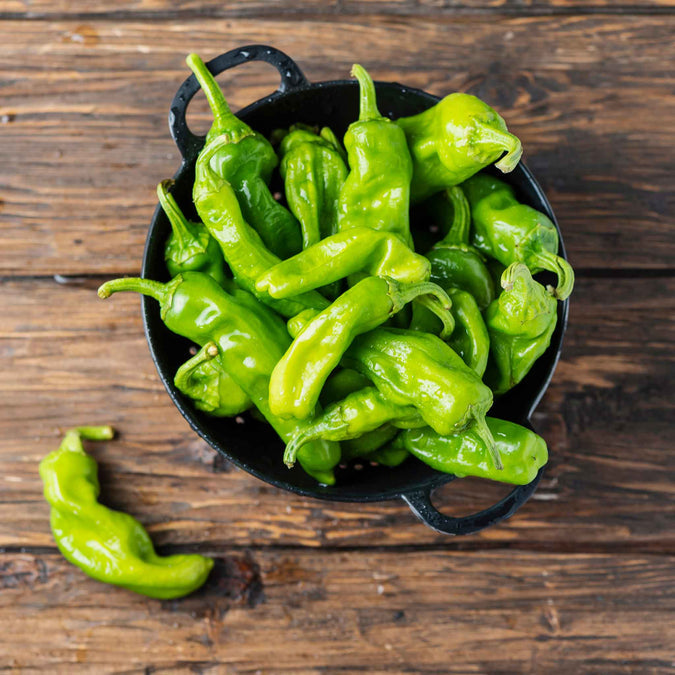
Dharaseeds
Sweet Pepper Seeds - Pepperoncini Italian
Estimated Free Delivery between April 17 and April 20.
Secured Payment Methods
Your transaction is protected with advanced security measures to keep your information confidential
Pepperoncini Italian peppers are a popular variety known for their mild heat, sweet flavor, and unique, wrinkled appearance. Often used in Italian cuisine, they offer a balance of tangy sweetness with just a hint of spice, making them a versatile addition to any garden. These peppers are commonly used fresh in salads, pickled for savory snacks, or included in Mediterranean dishes, offering a flavorful kick without overwhelming heat.
Key Benefits
- Mild Heat: Offers a mild to moderate heat level, making them perfect for those who prefer a pepper with just a touch of spice.
- Sweet, Tangy Flavor: Known for their unique blend of sweet and tangy flavors, ideal for pickling and cooking.
- Versatile in the Kitchen: Perfect for pickling, roasting, grilling, and as a topping for sandwiches, pizzas, and salads.
- High Yield: Produces an abundant harvest of peppers, ensuring a steady supply throughout the growing season.
- Compact Growth: Suitable for small spaces, container gardening, or raised beds due to its compact plant size.
Variety Features
- Plant Characteristics: Compact, bushy plants that typically grow to about 18–24 inches tall, with dark green leaves and abundant, small to medium-sized peppers.
- Flavor Profile: Mild heat with a sweet, tangy taste that deepens when pickled.
- Growth Habit: Peppers grow in clusters and have a wrinkled, tapered shape with a slight curve.
- Size: Peppers reach about 3–4 inches in length and 1–1.5 inches in width, with a bright green color that ripens to a reddish hue.
Planting Instructions
Planting Season
- Start seeds indoors 6–8 weeks before the last frost date or sow directly outdoors once the danger of frost has passed.
- Best suited for warm climates with long, hot growing seasons.
Planting Details
- Seed Depth: Plant seeds about 1/4 inch deep.
- Spacing: Space plants 18–24 inches apart to allow for healthy growth and proper air circulation.
- Soil Requirements: Prefers rich, well-drained soil with a pH of 6.0–7.0.
- Sunlight: Requires full sun for the best growth and fruit production.
Care Instructions
Watering
- Keep the soil consistently moist, providing about 1 inch of water per week.
- Water deeply, ensuring that the roots receive adequate moisture, but avoid overwatering to prevent root rot.
Fertilization
- Apply a balanced fertilizer at planting time and again when plants begin to set fruit.
- Avoid high-nitrogen fertilizers, as they can encourage excessive leaf growth at the expense of fruit production.
Weeding and Mulching
- Keep weeds under control to prevent competition for nutrients and water.
- Apply mulch to help retain moisture, regulate soil temperature, and reduce weed growth.
Pest and Disease Control
- Pests: Watch for aphids, spider mites, and thrips, which may infest pepper plants. Organic insecticidal soap or neem oil can help manage these pests.
- Diseases: Pepper plants are susceptible to fungal diseases such as powdery mildew and blight. Rotate crops annually and maintain good garden hygiene to reduce disease risk.
Harvesting
Maturity
- Pepperoncini Italian peppers typically reach maturity in 60–75 days, depending on growing conditions.
- Harvest when peppers are firm, bright green, and about 3–4 inches long, or wait for them to ripen to a reddish color for a slightly sweeter flavor.
Method
- Gently twist or cut the peppers from the plant, ensuring you leave a small portion of the stem attached.
Storage
- Short-Term: Fresh peppers can be stored in the refrigerator for up to 1–2 weeks.
- Long-Term: For long-term storage, pickle the peppers or freeze them. Alternatively, they can be dried and stored in airtight containers.
Culinary Uses
- Pickled: Pepperoncini peppers are commonly pickled and used in salads, sandwiches, and antipasto platters.
- Grilled or Roasted: Slice and grill or roast for a smoky flavor, perfect for pizzas, pasta dishes, or as a side.
- Stuffed: Use mild, fresh peppers for stuffing with cheese, meats, or grains.
- Fresh in Salads: Slice thinly and add to fresh salads for a sweet and tangy crunch. They also pair well with other Mediterranean ingredients like olives and tomatoes.
Conclusion
Sweet Pepper Seeds - Pepperoncini Italian is a great choice for gardeners looking to grow a mild, tangy pepper that offers both sweetness and just a touch of heat. Whether pickled, grilled, or used fresh in Mediterranean-inspired dishes, these peppers add a unique flavor to any recipe. With their high yield, compact size, and versatility in the kitchen, Pepperoncini Italian peppers are a must-have for home gardeners and chefs alike.









